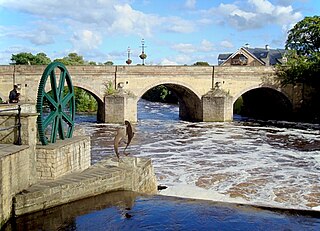| Industry | Housebuilding |
|---|---|
| Founded | 1933 |
| Defunct | 1972 |
| Fate | Acquired |
| Successor | Persimmon plc |
| Headquarters | Leeds, West Yorkshire, England |


Ashtons was a housebuilder in Yorkshire in the 1950s, 1960s and 1970s.
| Industry | Housebuilding |
|---|---|
| Founded | 1933 |
| Defunct | 1972 |
| Fate | Acquired |
| Successor | Persimmon plc |
| Headquarters | Leeds, West Yorkshire, England |


Ashtons was a housebuilder in Yorkshire in the 1950s, 1960s and 1970s.
Norman Ashton started his Leeds-based housebuilding business in 1933, and it was incorporated in 1938 as Norman C Ashton Ltd. Following the outbreak of war in 1939, the company was restricted to contracting for local authorities; it also established a motor repair business. [1] Private housebuilding resumed after the war and when Ashton was floated in 1964 it claimed to be one of the largest housebuilders operating in the West Riding. Growth was only modest thereafter and Ashton was acquired by Orme in 1972. [2]
The company constructed many homes in northern England during the 1960s and 1970s. It was one of several pioneers of the British three bed semi, a style of house used frequently from the 1940s until the 1970s, they also built many four and five bedroomed detached houses. Most Ashtons housing were built in close proximity with council housing; Holt Park in Leeds was a joint project between Ashtons and Leeds City Council. Ainsty in Wetherby is also a large mixed development with many Ashtons and Leeds City Council houses. Knottingley, Mirfield and Washington also include many Ashtons houses. [3]
The company was at the centre of a controversy concerning a covenant on one of their early developments in 1956. This resulted in the Bell v Norman C. Ashton Ltd (1956) P&CR 359 case which came before the Leeds Courts. Ashton had purchased land with a covenant that meant they could not build on it. [4] [ clarification needed ]

Wetherby is a market town and civil parish in the City of Leeds, West Yorkshire, England. It is close to West Yorkshire county's border with North Yorkshire, and lies approximately 12 miles from Leeds City Centre, 12 mi (19 km) from York and 8 mi (13 km) from Harrogate. The town stands on the River Wharfe, and for centuries has been a crossing place and staging post on the Great North Road midway between London and Edinburgh.
Holt Park is a medium-sized low-rise 1970s housing estate in the northwest suburbs of Leeds, West Yorkshire, England. It is approximately 6 miles (10 km) from Leeds city centre situated between Tinshill, Cookridge and Adel, and is at the edge of the Leeds urban fringe, bordering the green belt which makes up two thirds of the metropolitan borough of the City of Leeds. The nearby Tinshill BT Tower dominates the skyline.

George Wimpey was a British construction firm that typically worked in the civil engineering and housebuilding markets. It was, during the 1970s, the largest homebuilder active in the UK.
Bellway p l c is a residential property developer and housebuilder based in Newcastle upon Tyne, England. It is listed on the London Stock Exchange and is a constituent of the FTSE 250 Index.
Vistry Group, formerly Bovis Homes Group, is a British house-building company based in Kings Hill, England. Bovis Homes completed a deal to acquire Galliford Try's housing arm in January 2020, renaming the combined business Vistry. It is listed on the London Stock Exchange and is a constituent of the FTSE 250 Index.
Westbury plc was a British housebuilding company based in Cheltenham, Gloucestershire. It was listed on the London Stock Exchange and was a constituent of the FTSE 250 Index but was acquired by Persimmon plc in 2005.

Costain Group plc is a British construction and engineering company headquartered in Maidenhead, England.

Taylor Woodrow was one of the largest housebuilding and general construction companies in Britain. It was listed on the London Stock Exchange and was a constituent of the FTSE 100 Index until its merger with rival George Wimpey to create Taylor Wimpey on 3 July 2007.

Bryant Homes was one of the larger UK housebuilders when it was acquired by Taylor Woodrow in 2001; Bryant then became the principal housebuilding operation of the enlarged group. Taylor Woodrow merged with Wimpey in 2007 and during 2010 the Bryant brand was phased out. The company was first listed on the London Stock Exchange in 1962.

Wilson Bowden plc was a British housebuilding and general construction company headquartered in Coalville in central England.

Span Developments Limited was a British property development company formed in the late 1950s by Geoffrey Townsend working in long and close partnership with Eric Lyons as consultant architect. During its most successful period in the 1960s, Span built over 2,000 homes in London, Surrey, Kent and East Sussex – mainly two- and three-bedroom single-family homes and apartment buildings.
Tarmac Group Limited was a British building materials company headquartered in Wolverhampton, United Kingdom. It produced road surfacing and heavy building materials including aggregates, concrete, cement and lime, as well as operating as a road construction and maintenance subcontractor. The company was formerly listed on the London Stock Exchange and was once a constituent of the FTSE 100 Index.

The architecture of Leeds, a city and metropolitan borough in West Yorkshire, England, encompasses a wide range of architectural styles and notable buildings. As with most northern industrial centres, much of Leeds' prominent architecture is of the Victorian era. However, the City of Leeds also contains buildings from as early as the Middle Ages such as Kirkstall Abbey, one of Britain's best preserved ruined Cistercian monasteries, as well as examples of 20th century industrial architecture, particularly in the districts of Hunslet and Holbeck.
Broseley Estates Limited, also referred to as Broseley Homes, was a housebuilder based in Leigh, Lancashire which operated from the 1950s until the 1980s.
McLean Homes was a major British housebuilding business. It was bought by a major construction company, Tarmac, in 1972 and the brand ceased to be used in 1996.
Miller Homes Limited is a housebuilder based in the United Kingdom.

United House Developments is a property development and housebuilding company based in Southampton Street, London. It is active in the construction of social housing, urban regeneration, refurbishment and Public Private Partnerships (PPP).
Henry Boot plc is a British property development business based in Sheffield, England. It was floated on the London Stock Exchange in 1919, becoming the first quoted housebuilder. Between the wars, Henry Boot built more houses than any other company. The company remains a significant construction and property management company operating in the UK.
Beazer was a family business for six generations before expanding in the 1980s into an international housebuilding, construction, and building materials group. After becoming overburdened with debt it was rescued by Hanson plc in 1991. A new Beazer Group, comprising solely the UK housebuilding business, was demerged from Hanson in 1994, and bought by Persimmon plc in 2001.
Ideal Homes was a British housebuilder.